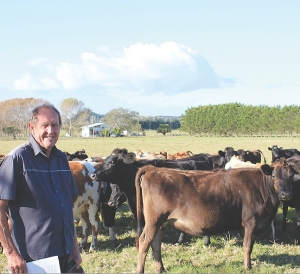Gray’s team milks 740 cows on a 240ha dairy platform in Awanui, 10km north of Kaitaia.
A much-respected farmer in the district, Gray is on the management committee for the Far North Monitor farm and is a regular speaker at DairyNZ and Beef and Lamb NZ field days.
While Gray has made a name for himself in farming in the far North he originally started his working life as a microbiologist in Whangarei and Oxford, England.
The Grays shifted to the northern part of New Zealand for a better quality of life, working full-time at a Whangarei base hospital while running a 300-ewe sheep and beef farm at Opawhanga.
Gray considered moving into dairying and seven enjoyable milkings on his neighbour’s farm sealed the deal, he says. “I really enjoyed that so I sold the big lifestyle block and went for it.”
He bought his first farm in Takahue, 20km south-east of Kaitaia, in 1981. To that 79ha block carrying 150 cows, he added a lease block and another adjacent farm, which he ran separately over the next 10 years.
Seven years ago he purchased a 122ha dairy farm in Awanui which he used as a base for the rest of the farm, gradually adding five dry stock properties and runoffs to the operation.
Gray’s process usually involves regrassing, laying drains and putting down races before stocking land at three cows to the hectare. Kaitaia flats is a great area to farm, he says.
“Adding blocks becomes easier once you’ve done it once. The Kaitaia Flats are underrated and a few guys have lifted the expectations on what can be produced up here.”
The fertile Far North plains, farm expansion and careful property management have helped farm production lift from an initial 86,000kgMS from the original 300 cows on 120ha to 290,000kgMS this season.
Good pasture management is a main driver behind growth in production with attention being paid to grass growth and pasture health.
Gray’s team does pasture walks over the entire property every 10 days with a plate meter to check on grass growth and is careful to get cows off pasture once residual covers are at 1500 kgDM/ha.
He is just as fast to control long grass growth through mulching and grass silage.
Management through winter and spring can be perilous as the half heavy Kaitaia clay is especially prone to pugging.
During winter and spring, weather is watched carefully with cows being stood off on in the cow yard if it doesn’t look good. “Pasture damage losses can be up to 40% with pugging,” Gray says.
Managing damage is crucial given the region’s dry summers, says Gray. Parts of the North are facing their third drought in seven years with moisture levels on the Awanui farm below average from the middle of October last year.
The property has grown two and a half tons less pasture than the previous year resulting in a heavier reliance on extra PKE. Much of the farm is kikuyu based.
He mulches and undersows Italian ryegrass on the entire farm in autumn to guarantee pasture growth remains strong through winter and spring when kikuyu doesn’t grow as well.
As the farm is rectangular with the shed at one end of the property Gray divides his herd into two different groups, a 160 ‘priority’ herd made up of young, lame and old cows and a 480 herd of the strongest cows.
The priority herd is kept on a round in paddocks close to the shed while the larger herd grazes at the other end of the farm of the shed.
Cows are milked in a 40 aside shed which has grown with the operation.
Starting out as a 28-aside herringbone, Gray says the shed was laid out well enough to be extended to a 40-aside with enough space to have a pro-track automatic drafting system installed. “Basically we just need three to run, one getting the cows in and putting cows away and two milking,” he says.
“With the automatic drafting, milking takes about three hours at the peak,” he says.
Gray has been developing the larger farm as he knows the dairy industry and was still enjoying getting out on the farm. “I see a lot of farmers retire farming and invest in something they are not familiar with.
“Land is something tangible that I can enjoy, dairying is an exciting area to work in and I still very much enjoy playing a hands-on roll in the industry.”
Having put together a team of five full-time staff members, Gray says he has developed a flat management style which allows everybody a say and enables him to take a step back from the day to day running of the farm when need be.
















